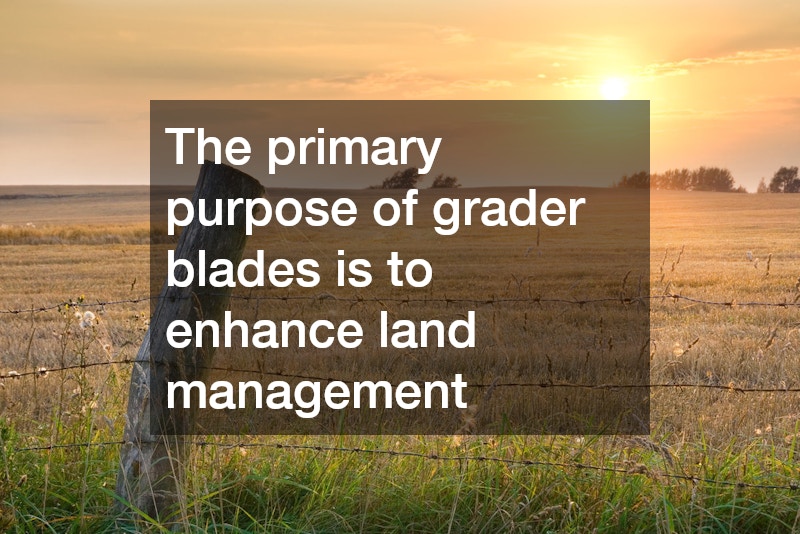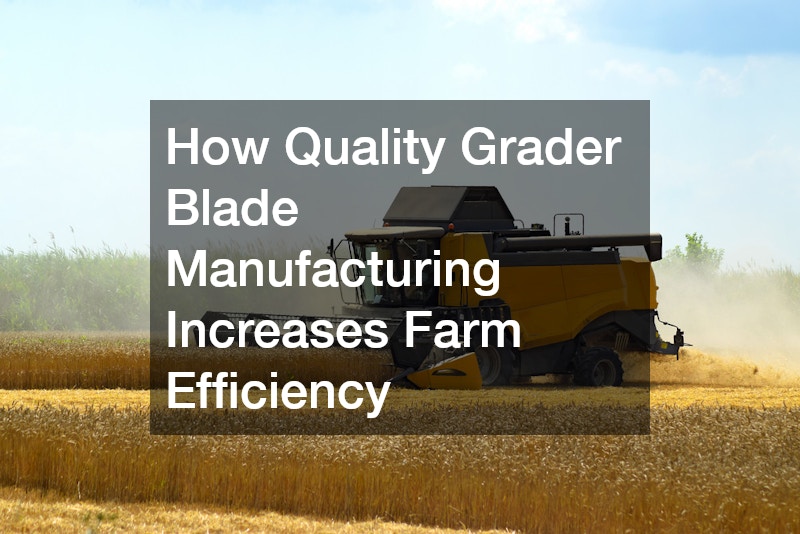A grader blade is a pivotal component in various agricultural machinery, playing a crucial role in tasks such as land leveling, maintenance, and soil conservation. Grader blade manufacturing is essential to provide these parts. The efficiency of farming operations is significantly influenced by the quality of these grader blades.
Farmers depend on high-performance blades to ensure their fields are optimally prepared for planting and cultivating crops, which directly affects yield and productivity levels.
The importance of quality in the manufacturing of grader blades cannot be overstated, as their effectiveness directly correlates with the efficiency of their operation in the field. Poorly manufactured blades can lead to increased downtime, more frequent replacements, and subpar performance, ultimately hindering overall farm efficiency. Conversely, high-quality grader blades enhance the ability to manage land effectively, ultimately resulting in better farming outcomes.
The Purpose of Grader Blades
Grader blades are essential attachments for various types of agricultural equipment, such as tractors and graders, used primarily for land leveling and grading purposes. They play a significant role in preparing the soil for agricultural activities by smoothing and flattening surfaces, allowing for better water drainage and nutrient distribution. This ensures that crops have the optimal foundation for growth, which is essential for achieving high yields.
The primary purpose of grader blades is to enhance land management. By creating a uniform surface, these blades help prevent water runoff and soil erosion, thereby contributing to soil health and fertility. A well-maintained field not only helps in sowing and maintaining crops but also aids in protecting the land from harsh weather conditions, ultimately ensuring long-term sustainability in agriculture.
Besides land leveling, grader blades can also contribute to maintaining farm roads and drainage ditches. Their versatility makes them valuable tools in various agricultural operations, highlighting the importance of investing in high-quality blades that can withstand the rigors of farming. As such, the right grader blades can lead to significant improvements in productivity and efficiency.
The Impact of Quality Manufacturing
The manufacturing process of grader blades significantly impacts their performance and durability in the field. High-quality production involves stringent quality control measures, including the use of precision engineering techniques and robust testing protocols. This ensures that the blades are not only sharp but also maintain their edge under stressful conditions, leading to optimal performance during operations.
Moreover, the consistency in manufacturing quality results in fewer defects and greater reliability. Quality-manufactured blades are designed to withstand harsh working environments, minimizing the risk of breakage and reducing the need for frequent replacements. In contrast, inferior manufacturing can lead to blades that dull quickly or suffer from structural failure, causing inefficiencies during fieldwork.
Additionally, the relationship between manufacturing quality and blade performance can influence overall cost-efficiency for farms. Investing in high-quality grader blades minimizes downtime and maintenance costs, while enhancing productivity during peak planting and harvesting seasons. A focus on quality manufacturing translates to better economic outcomes for farmers, highlighting its vital role in modern agricultural operations.
The Commonly Used Materials
The materials used in the production of grader blades greatly contribute to their durability, performance, and overall effectiveness in the field. High-quality blades are typically made from heavy-duty steel, which offers a superior balance of strength, hardness, and wear resistance. This ensures that the blades can endure the rigorous demands of land leveling and soil management without succumbing to wear over time.
Additionally, advanced materials such as high-strength alloys and composite materials may also be used to enhance performance characteristics. These materials are engineered to offer increased resilience and reduced weight, allowing for more efficient operation without compromising the blade’s effectiveness. The choice of material plays a crucial role in determining the blade’s longevity and performance under various agricultural conditions.
Furthermore, heat treatment processes applied to these materials can significantly improve their properties, resulting in blades that resist deformation and maintain their cutting edge longer. This focus on material quality ensures that farmers can rely on their grader blades to perform optimally, leading to increased efficiency in farming operations and ultimately impacting productivity positively.
The Right Blades for Your Needs
Selecting the appropriate grader blades involves assessing various factors, including the type of soil, the intended use, and the specific requirements of agricultural operations. Farmers should consider the blade’s size, shape, and material composition to ensure compatibility with their machinery and farming practices. Understanding these factors can prevent costly mistakes and lead to more efficient farming methods.
Another important aspect is to evaluate the quality of the manufacturer. Reputable brands often provide detailed product specifications and performance reviews, which can guide farmers in making informed decisions. Investing time in research and consulting with industry experts or fellow farmers can provide insights into the most suitable grader blades for specific farming conditions.
Finally, farmers should also consider future adaptability. As farming technology evolves, the demand for versatile grader blades that can accommodate different attachments and evolving practices may become essential. Selecting a blade that integrates well with existing technology can increase farm efficiency and productivity over the long term.
The Long-Term Benefits
Investing in high-quality grader blades can yield significant long-term benefits for farmers. The durability and performance of these blades often result in substantial cost savings over time due to reduced maintenance and replacement needs. Farmers using high-quality grader blades experience fewer breakdowns, which directly translates to improved productivity and less downtime during critical farming periods.
Additionally, quality grader blades can enhance land management practices. By ensuring that fields are properly leveled and maintained, these blades contribute significantly to soil health, preventing erosion and promoting better water retention and nutrient absorption. This not only results in improved crop yields but also supports sustainable agricultural practices, helping to guard against future environmental challenges.
The return on investment associated with quality grader blades often extends beyond tangible savings. Improved efficiency, increased productivity, and better crop yields all contribute to enhanced farm profitability. Thus, the decision to invest in high-quality grader blades becomes a strategic one for farmers seeking to optimize their operations and ensure long-term success in an increasingly demanding agricultural landscape.
The quality of grader blade manufacturing plays a vital role in enhancing farm efficiency. From understanding the importance of materials and manufacturing processes to selecting the right blades for specific farming operations, farmers are empowered to make informed decisions that contribute to overall productivity. The benefits of investing in quality grader blades are clear, with long-term advantages that extend beyond immediate cost savings to encompass broader impacts on soil health, sustainability, and farm profitability. The importance of choosing quality grader blades cannot be overstated, as it directly correlates with successful farming operations and the future of agriculture.

